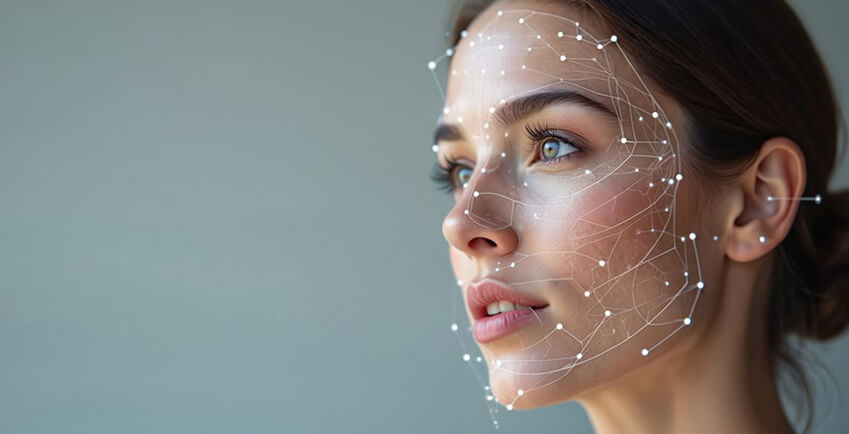“Artificial intelligence is ushering in a new era of aesthetic medicine where data meets design, and every procedure is guided by prediction, personalisation, and precision”
The integration of artificial intelligence (AI) into modern medicine has transformed diagnostic accuracy, clinical decision-making, and procedural outcomes across multiple specialities, and now, it’s bringing that same intelligence to the art of aesthetic surgery. In aesthetic surgery, AI is being increasingly utilised to enhance patient evaluation, surgical planning, and postoperative monitoring. Cosmetic clinics are using AI-driven tools for facial analysis, injectable planning, robotic-assisted procedures, and complication risk reduction strategies. These innovations promise to transform cosmetic clinics by personalising care, enhancing surgical and non-surgical precision, and improving patient safety in both facial and body contouring procedures, marking a paradigm shift in the way aesthetic medicine is delivered. So, let us delve into some of the details of these.
AI Facial Analysis
Do Algorithms see beauty differently?
Facial harmony and proportion are central to aesthetic procedures, yet conventional assessment often relies on the surgeon’s subjective evaluation. AI-powered facial analysis employs deep learning algorithms to objectively evaluate symmetry, proportionality, and ageing patterns. Advanced systems generate three-dimensional (3D) facial models and simulate surgical or nonsurgical interventions, providing patients with realistic before-and-after projections. It employs sophisticated facial analysis tools that capitalise on 3D imaging and advanced neural networks to objectively assess facial features, symmetry, and proportions. These systems provide facial harmony analysis, measuring unique ratios and creating individualised symmetry plans for each patient. This enables clinicians to develop highly customised treatments for procedures like rhinoplasty, facelifts, eyelid surgery and so on.
AI facial analysis can also quantify subjective aesthetic qualities, providing objective metrics that previously depended on expert opinion alone. Large-scale AI models not only analyse photographic images but can also integrate genetic data and medical records. By combining all these, AI supports more individualised and contextualised treatment planning, ensuring interventions are tailored to each unique patient profile. Interesting to note is that, beyond preoperative planning, AI enables standardised documentation, ensuring reproducibility and accuracy in tracking outcomes over time, which in turn facilitates research, quality assurance, and continuous improvement in patient care.
Artificial Intelligence in Cosmetic Procedures
The Trinity of Knife, Syringe, and AI
AI applications extend well beyond diagnostic support, reaching into the procedural domain itself. When developing surgical or minimally invasive treatment plans, AI can process vast quantities of patient data—factoring in age, body type, skin quality, healing potential, and even anticipated long-term facial changes. AI’s predictive modelling capabilities guide surgeons in selecting techniques that maximise aesthetic outcomes while minimising complications.
Through simulation software, AI generates realistic predictions of post-procedural appearance. Surgeons use these visualisations in consultations, giving patients a better understanding of potential results, setting realistic expectations, and boosting confidence in their care. This also assists with informed consent and strengthens trust between patient and provider.
Moreover, AI-driven imaging systems are being integrated into minimally invasive procedures like microneedling, radiofrequency, and laser resurfacing, where precision of depth and energy delivery directly influences outcomes. By reducing intra-operator variability, AI ensures greater consistency and reproducibility in aesthetic interventions.
AI-Driven Patient Assessment and Risk Prediction in Cosmetic Surgery
Patient selection and risk stratification remain critical determinants of success in cosmetic surgery. AI enhances this process by integrating demographic, genetic, and clinical data to generate personalised risk profiles. Predictive analytical models can calculate individualised risk scores for surgical complications. For example, predictive models can forecast the likelihood of adverse scarring, infections, delayed healing, or dissatisfaction based on prior surgical outcomes and patient factors. These tools support patient selection, enhance preoperative counselling, and inform surgeons’ intraoperative and postoperative vigilance, contributing directly to lower complication rates and better outcomes. By this, these systems also support ethical practice by preventing inappropriate patient selection, identifying high-risk candidates, and highlighting unrealistic expectations. In doing so, AI complements the surgeon’s expertise and fosters safer, more patient-centred care.
AI in Objective Postoperative Evaluation
Post-surgical results are now analysed using AI systems to calculate changes in facial or bodily symmetry, monitor healing, and assess patient satisfaction. Machine learning models track recovery by comparing pre- and post-operative images. They identify even subtle improvements or complications, providing actionable data for early intervention and continuous care quality improvement. These systems can also be used for research and auditing, offering quantifiable outcome data that helps clinics refine techniques and benchmark performance metrics over time.
AI for Injectables and Fillers Planning
The demand for non-surgical aesthetic procedures, particularly botulinum toxin and dermal fillers, continues to rise globally, and AI now plays a pivotal role in treatment planning and delivery of these. Algorithms analyse 2D and 3D facial images to detect subtle asymmetries and volume loss, thereby enabling practitioners to plan the exact dosage, placement, and depth, predicting the effect on facial volume and symmetry over time. By combining predictive artificial intelligence (AI) algorithms with augmented reality (AR)–based real-time injection guidance, clinicians can achieve enhanced precision and safety in filler procedures. This integrated approach minimises complications such as asymmetry, lumpiness, overfilling, and vascular compromise, while improving aesthetic harmony, reducing the need for corrective touch-ups, and ensuring more durable, natural-looking outcomes.
Robotic Cosmetic Procedures
The emergence of robotic platforms in cosmetic surgery represents the next frontier. A shining instance of this is hair transplantation. AI-guided robotic systems have demonstrated success in hair transplantation, where they automate graft harvesting and placement with remarkable precision. In skin resurfacing and laser-assisted procedures, robots provide controlled energy delivery, reducing operator fatigue and error. While human oversight remains essential, robotic technology will likely become a critical adjunct in improving safety and reproducibility. Future developments might see semi-autonomous robotic assistance in facelifts, liposuction, and blepharoplasty, where AI could augment the surgeon’s hands with enhanced steadiness and precision. AI-assisted navigation enhances precision and protects vital structures, collectively minimising surgical errors and postoperative morbidity.
AI for Reducing Surgical Complications
As already said, AI’s predictive power is redefining safety in cosmetic surgery. By analysing vast datasets, it uncovers subtle risk patterns for infection, hematoma, delayed healing, or suboptimal outcomes that may escape human detection. Surgeons can then individualise techniques and postoperative care according to each patient’s risk profile. Continuously learning from new data, AI systems update risk models and management protocols in real time, ensuring patient safety evolves alongside innovation.
Challenges, Ethics, and the Road Ahead
While AI is rapidly transforming cosmetic surgery, its widespread adoption is limited by high costs, insufficient external validation, and a lack of comprehensive multi-centre studies. Ethical challenges—including data privacy, algorithm transparency, and the risk of over-reliance—demand careful attention. Moving forward, a balance between technological innovation and the artistic, individualised judgment of skilled surgeons will be crucial to ensure safe, ethical, and patient-centred aesthetic care
Takeaways
Thus, AI is revolutionising cosmetic clinics by blending artistry with intelligent precision—delivering more personalised, safer, and efficient care than ever before. However, challenges remain: high implementation costs, the need for specialist training, and concerns around data privacy mean that human expertise remains essential for both ethical judgement and optimal outcomes. The future of aesthetic practice will thrive on this powerful partnership between innovation and experience.
Author: Dr P Umar Farooq Baba, SKIMS, Srinagar
Phone: +91 9419081397
IAAPS No: 2023/JK/05
Email: drumar397@gmail.com
Disclaimer : The opinions here are personal views of the authors. IAAPS is not responsible. All members may not have the same scientific view point

